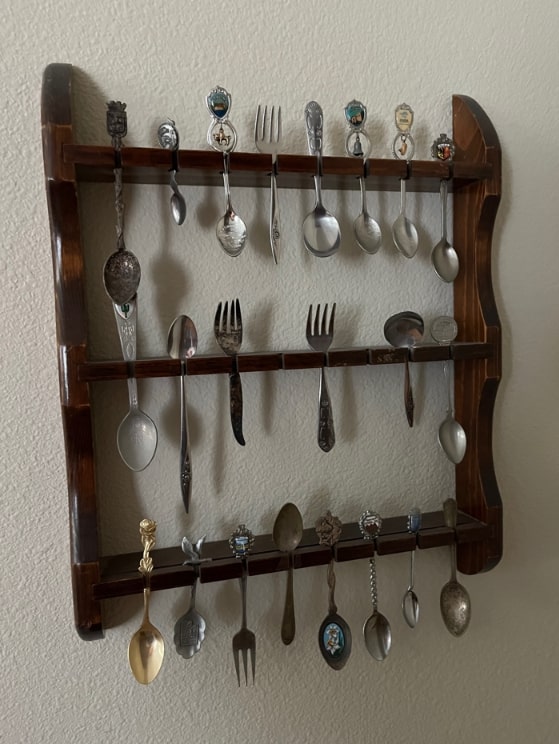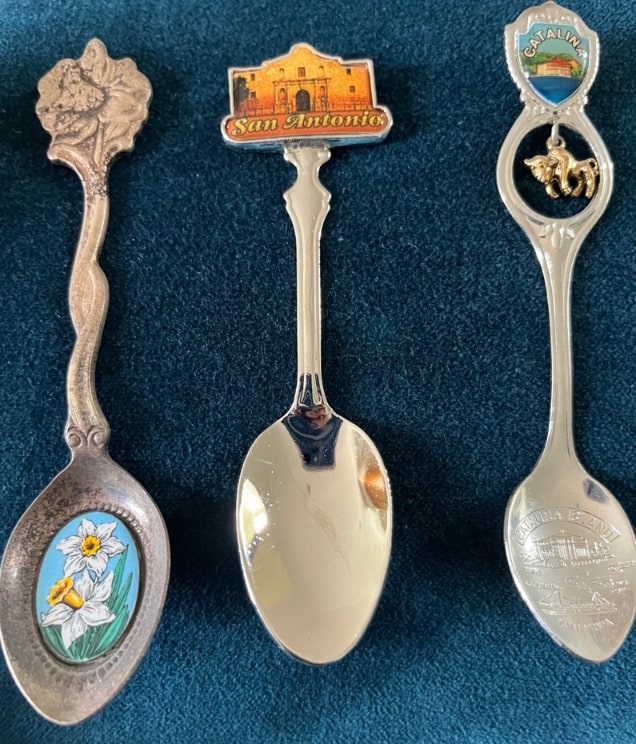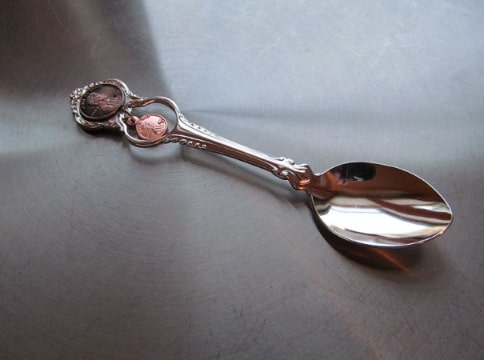Introduction: In this article, Gena Philibert-Ortega writes about her collection of souvenir spoons, begun by her mother. Gena is a genealogist and author of the book “From the Family Kitchen.”
Does your family have a souvenir spoon collection? Maybe at a family member’s home, or your own, there is a spoon holder attached to a wall that showcases tiny spoons from places where the family has traveled. My collection, started by my mom, includes spoons she collected in Europe as well as ones I’ve picked up over the years.

These easily ignored souvenir trinkets actually have an interesting history, and they may reflect on your ancestor’s travels and interests.
American Souvenir Spoons
Souvenir spoons have their origin in mid-19th century Europe. “Wealthy Americans on a Grand Tour of Europe brought home these souvenirs marked with the names of cities and some of the famous landmarks they had seen.” (1) Eventually American silversmiths caught on to the idea. The first American souvenir spoon was created in 1889 to mark the 100th anniversary of George Washington’s presidency. (2)
A few American souvenir spoons existed in 1890, and by 1891 souvenir spoons had been created to commemorate “cities and towns, famous people, historical events and significant events of the time.” (3)

One example is described in this 1891 Plain Dealer article that proclaimed the souvenir spoon craze was increasing. The article begins by discussing one of the earlier American souvenir spoons depicting the Salem (Massachusetts) witches, in response to a poem by Oliver Wendall Homes published in the Atlantic Monthly. The spoon is described as having a straight handle “like a broomstick, and at its upper end was a tiny figure of a Salem witch sitting on a rock and holding a broom diagonally across her breast.”
The article discussed other local souvenir spoons for Boston (with a bean pot on the handle and the old South church in the bowl), Plymouth (with the Mayflower), and Newburyport (with the old chain bridge).
According to the website for the PBS show History Detectives, the 1893 Chicago World’s Fair marked the golden age of souvenir spoon collecting and introduced spoons to an audience of 27 million visitors. (4) Prior to the fair an estimated 180,000 spoons were ordered, but it was believed that 500,000 were eventually produced for the concessions.
This 1893 Trenton Times article refers to 100 designs for the Fair, and a search of an online auction website shows numerous spoons that depict Christopher Columbus and the words “1893 World’s Fair,” with the bowl of the spoon depicting various buildings at the Fair, such as Manufacturers & Liberal Arts, the Art Palace, the Administration Building, the Mines and Mining Building, as well as others.
Why were souvenir spoons so popular? This 1893 Buffalo News article describing a variety of spoons stated:
“The spoon is a pretty lasting and suitable gift for either a lady or a gentleman friend upon almost any occasion. When other gifts have decayed with fashion fancies or worn out with wear, the spoon will still adorn the table of the sick room as a happy reminder of the thoughtful giver.”
Collecting Spoons
Today, you might find souvenir spoons at an airport or a tourist gift shop – but when they began, spoons were sold by jewelers, silversmiths, and even given away as a premium by newspapers. This example from 1893 is for the Columbian Souvenir Spoon (the 1893 World’s Fair was called the Columbian Exposition, celebrating the 400th anniversary of Christopher Columbus’ arrival in the “New World”). This premium was given to those who subscribed or renewed to the Weekly Wisconsin newspaper and the Ladies Home Companion for $1. Subscribers received the spoon as a free gift.
Other newspapers also offered souvenir spoons as premiums or for purchase, including sets of spoons for each of the states.
If your ancestor collected spoons, they may have joined a souvenir spoon club. In this 1906 example from Duluth, Minnesota, the club members met at different homes to play cards and the hostess would receive a spoon.
Genealogy Tip: Local club activity notices in newspapers can be helpful in learning more about your ancestor’s interests and memberships. In some cases, it might even lead to records.
Did Your Family Collect Spoons?
It appears the golden age of souvenir spoons ended after World War I. That doesn’t mean people no longer collected them, they just weren’t as much of a fad as they had been previously. Why? I’m not sure, but it’s possible other collectibles took their place.
Did your family collect spoons? What’s in their collection? What can you learn about their interest or travels from their spoons? Please let me know in the comments below.
Explore over 330 years of newspapers and historical records in GenealogyBank. Discover your family story! Start a 7-Day Free Trial
Note on the header image: souvenir spoon from Ford’s Theatre, Washington, D.C. Credit: John Phelan; Wikimedia Commons.
__________________
(1) “History of Souvenir Spoons,” History Detectives (https://www.pbs.org/opb/historydetectives/feature/history-of-souvenir-spoons/: accessed 30 May 2023).
(2) Ibid.
(3) Ibid.
(4) Ibid.
